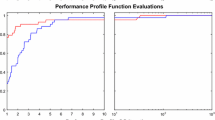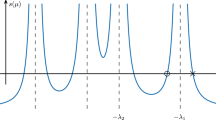Abstract
A procedure is described for preventing cycling in active-set methods for linearly constrained optimization, including the simplex method. The key ideas are a limited acceptance of infeasibilities in all variables, and maintenance of a “working” feasibility tolerance that increases over a long sequence of iterations. The additional work per iteration is nominal, and “stalling” cannot occur with exact arithmetic. The method appears to be reliable, based on computational results for the first 53 linear programming problems in theNetlib set.
Similar content being viewed by others
References
M.L. Balinski and R.E. Gomory, “A mutual primal-dual simplex method,” in: R.L. Graves and P. Wolfe, eds.,Recent Advances in Mathematical Programming (McGraw-Hill, New York, 1963).
E.M.L. Beale, “Advanced algorithmic features for general mathematical programming systems,” in: J. Abadie, ed.,Integer and Nonlinear Programming (North-Holland, Amsterdam, 1970) pp. 119–137.
M. Benichou, J.M. Gauthier, G. Hentges and G. Ribière, “The efficient solution of large-scale linear programming problems—some algorithmic techniques and computational results,”Mathematical Programming 13 (1977) 280–322.
R.G. Bland, “New finite pivoting rules for the simplex method,”Mathematics of Operations Research 2 (1977) 103–107.
A. Brooke, D. Kendrick and A. Meeraus,GAMS: A User's Guide (The Scientific Press, Redwood City, CA, 1988).
G.B. Dantzig,Linear Programming and Extensions (Princeton University Press, Princeton, NJ, 1963).
G.B. Dantzig, “Making progress during a stall in the simplex algorithm,” Report SOL 88-5, Department of Operations Research, Stanford University (Stanford, CA, 1988).
G.B. Dantzig, A. Orden and P. Wolfe, “The generalized simplex method for minimizing a linear form under linear inequality constraints,”Pacific Journal of Mathematics 5 (1955) 183–195.
J.C. Falkner, “Bus crew scheduling and the set partitioning model,” Ph.D. thesis, Department of Theoretical and Applied Mechanics, University of Auckland (Auckland, New Zealand, 1988).
J.C. Falkner and D.M. Ryan, “Aspects of bus crew scheduling using a set partitioning model,” Fourth International Workshop on Computer-Aided Scheduling of Public Transport (Hamburg, 1987).
R. Fletcher,Practical Methods of Optimization: Vol. 2: Constrained Optimization (Wiley, Chichester and New York, 1981).
R. Fletcher, “Degeneracy in the presence of round-off errors,” Technical Report NA/89, Department of Mathematical Sciences, University of Dundee (Dundee, 1985).
R. Fletcher, “Recent developments in linear and quadratic programming,” in: A. Iserles and M.J.D. Powell, eds.,The State of the Art in Numerical Analysis (Oxford University Press, Oxford and New York, 1987) pp. 213–243.
R. Fletcher and M.P. Jackson, “Minimization of a quadratic function of many variables subject only to upper and lower bounds,”Journal of the Institute of Mathematics and its Applications 14 (1974) 159–174.
R. Fourer, “A simplex algorithm for piecewise-linear programming I: derivation and proof,”Mathematical Programming 33 (1985) 204–233.
R. Fourer and D.M. Gay, private communication (1989).
D.M. Gay, “Electronic mail distribution of linear programming test problems,”Mathematical Programming Society COAL Newsletter 13 (1985) 10–12.
P.E. Gill, S.J. Hammarling, W. Murray, M.A. Saunders and M.H. Wright, “User's Guide for LSSOL (Version 1.0): a Fortran package for constrained linear least-squares and convex quadratic programming,” Report SOL 86-1, Department of Operations Research, Stanford Univesity (Stanford, CA, 1986).
P.E. Gill and W. Murray, “Numerically stable methods for quadratic programming,”Mathematical Programming 14 (1978) 349–372.
P.E. Gill, W. Murray, M.A. Saunders and M.H. Wright, “User's Guide for SOL/QPSOL (revised),” Report SOL 84-6, Department of Operations Research, Stanford University (Stanford, CA, 1984).
P.E. Gill, W. Murray and M.H. Wright,Practical Optimization (Academic Press, London and New York, 1981).
G.W. Graves, “A complete constructive algorithm for the general mixed linear programming problem,”Naval Research Logistics Quarterly 12 (1965) 1–34.
H.J. Greenberg, “Pivot selection tactics,” in: H.J. Greenberg, ed.,Design and Implementation of Optimization Software (Sijthoff and Noordhoff, Alphen aan den Rijn, 1978) pp. 143–174.
P.M.J. Harris, “Pivot selection methods of the Devex LP code,”Mathematical Programming 5 (1973) 1–28. [Reprinted inMathematical Programming Study 4 (1975) 30-57.]
E.S. Klotz,Dynamic pricing criteria in linear programming, Ph.D. thesis, Department of Operations Research, Stanford University (Stanford, CA, 1988).
I.J. Lustig, “An analysis of an available set of linear programming test problems,” Report SOL 87-11, Department of Operations Research, Stanford University (Stanford, CA, 1987). [See alsoComputers and Operations Research 16 (1989) 173–184.]
B.A. Murtagh and M.A. Saunders, “MINOS 5.0 User's Guide,” Report SOL 83-20, Department of Operations Research, Stanford University (Stanford, CA, 1983).
B.A. Murtagh and M.A. Saunders, “MINOS 5.1 User's Guide,” Report SOL 83-20R, Department of Operations Research, Stanford University (Stanford, CA, 1987).
J.L. Nazareth, “Implementation aids for the optimization algorithms that solve sequences of linear programs,”ACM Transactions on Mathematical Software 12 (1986) 307–323.
J.L. Nazareth,Computer Solution of Linear Programs (Oxford University Press, New York and Oxford, 1987).
W. Ogryczak, “On practical stopping rules for the simplex method,”Mathematical Programming Study 31 (1987) 167–174.
W. Orchard-Hays,Advanced Linear-Programming Computing Techniques (McGraw-Hill, New York, 1968).
J.M. Ortega and W.C. Rheinboldt,Iterative Solution of Nonlinear Equations in Several Variables (Academic Press, London and New York, 1970).
M.R. Osborne,Finite Algorithms in Optimization and Data Analysis (Wiley, New York, 1985).
R.T. Rockafellar,Network Flows and Monotropic Optimization (Wiley, New York, 1984).
D.M. Ryan and M.R. Osborne, “On the solution of highly degenerate linear programs,”Mathematical Programming 41 (1988) 385–392.
J.H. Wilkinson,The Algebraic Eigenvalue Problem (The Clarendon Press, Oxford, 1965).
P. Wolfe, “The reduced-gradient method,” unpublished manuscript, the RAND Corporation (1962).
P. Wolfe, “A technique for resolving degeneracy in linear programming,”SIAM Journal of Applied Mathematics 11 (1963) 205–211.
P. Wolfe, “The composite simplex algorithm,”SIAM Review 7 (1965) 42–54.
Author information
Authors and Affiliations
Additional information
The material contained in this report is based upon research supported by the Air Force Office of Scientific Research Grant 87-01962; the U.S. Department of Energy Grant DE-FG03-87ER25030; National Science Foundation Grants CCR-8413211 and ECS-8715153; and the Office of Naval Research Contract N00014-87-K-0142.
Rights and permissions
About this article
Cite this article
Gill, P.E., Murray, W., Saunders, M.A. et al. A practical anti-cycling procedure for linearly constrained optimization. Mathematical Programming 45, 437–474 (1989). https://doi.org/10.1007/BF01589114
Issue Date:
DOI: https://doi.org/10.1007/BF01589114




